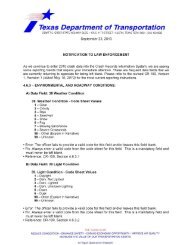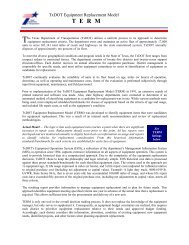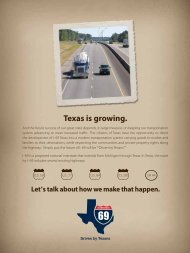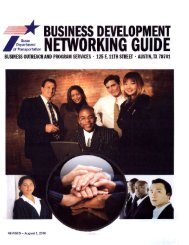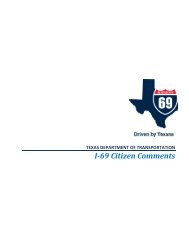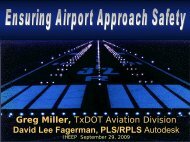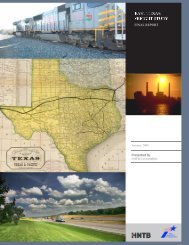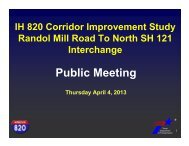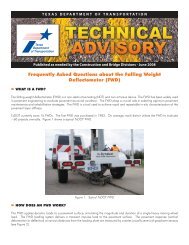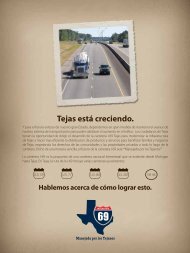TxDOT has a Plan - Welcome to the Texas Department of ...
TxDOT has a Plan - Welcome to the Texas Department of ...
TxDOT has a Plan - Welcome to the Texas Department of ...
Create successful ePaper yourself
Turn your PDF publications into a flip-book with our unique Google optimized e-Paper software.
OUR<br />
Strategic <strong>Plan</strong><br />
Our Goals<br />
GOAL 1:<br />
Reduce congestion<br />
Congestion is not <strong>the</strong> only challenge our<br />
system faces, but <strong>to</strong> many Texans, it is <strong>the</strong><br />
most visible. According <strong>to</strong> <strong>the</strong> Federal<br />
Highway Administration, most congestion is<br />
caused by bottlenecks, with traffic accidents<br />
as <strong>the</strong> next highest contribu<strong>to</strong>r.<br />
Congestion on <strong>the</strong> roadway begins when a<br />
route approaches 90 percent <strong>of</strong> its operating<br />
capacity. At this point, average vehicle speed<br />
begins <strong>to</strong> decrease. Light congestion may<br />
increase <strong>to</strong>tal trip time by only 10-20 percent,<br />
while severe congestion can double or triple<br />
<strong>to</strong>tal trip time.<br />
The <strong>Texas</strong> Transportation Institute’s<br />
researchers, in <strong>the</strong>ir 2005 Urban Mobility Study<br />
found that many <strong>of</strong> <strong>Texas</strong>’ metropolitan areas<br />
(Dallas, Fort Worth, Hous<strong>to</strong>n, San An<strong>to</strong>nio,<br />
Austin, El Paso, Laredo, Corpus Christi,<br />
Beaumont and Brownsville) are within <strong>the</strong> <strong>to</strong>p<br />
85 congested areas in <strong>the</strong> country. Hous<strong>to</strong>n<br />
ranked fifth for traveler delay. Dallas, Fort<br />
Worth and Arling<strong>to</strong>n ranked sixth.<br />
While traffic congestion is annoying <strong>to</strong><br />
mo<strong>to</strong>rists, it is costly <strong>to</strong> all Texans. Congestion<br />
on our roadways costs Texans an average <strong>of</strong><br />
$6.2 billion each year.<br />
So how do we unlock <strong>the</strong> gridlock now chipping<br />
away at our economy and wasting Texans’<br />
quality time? We at <strong>the</strong> department and<br />
our regional partners are moving forward<br />
with short-, mid-, and long-term tactics<br />
such as Pass-Through Toll Financing,<br />
Regional Mobility Authorities, and <strong>the</strong><br />
Trans-<strong>Texas</strong> Corridor.<br />
GOAL 2:<br />
Enhance safety<br />
We have a long-standing commitment <strong>to</strong><br />
ensure that roadways are designed and<br />
maintained for safety. Our new technologies<br />
and new communications <strong>to</strong>ols ga<strong>the</strong>r<br />
accurate and timely data about potentially<br />
unsafe roadway conditions. Breakaway signs,<br />
crash attenua<strong>to</strong>rs, median barriers, skidresistant<br />
pavements, and safety lighting are<br />
all examples <strong>of</strong> innovations incorporated in<strong>to</strong><br />
<strong>the</strong> design <strong>of</strong> <strong>to</strong>day’s roadways.<br />
The average Texan drives more than 10,000<br />
miles per year over <strong>the</strong> course <strong>of</strong> 1,500 trips.<br />
Every year, vehicle crashes cost <strong>the</strong> U.S.<br />
economy more than $230 billion. About onequarter<br />
<strong>of</strong> <strong>the</strong> cost <strong>of</strong> those traffic accidents<br />
is paid directly by those involved, while <strong>the</strong><br />
rest is passed on <strong>to</strong> <strong>the</strong> public.<br />
We are continuously looking at new<br />
innovations and policies <strong>to</strong> enhance safety.<br />
Each year, we commission research <strong>to</strong> develop<br />
new technology and improved structures<br />
and pavements <strong>to</strong> enhance <strong>the</strong> safety <strong>of</strong><br />
<strong>Texas</strong> roads, bridges and tunnels.<br />
Policies aimed at segregating large trucks from<br />
general traffic have been very successful in areas<br />
such as Hous<strong>to</strong>n. The TTC, a multi-use statewide<br />
network <strong>of</strong> transportation routes, <strong>of</strong>fers a more<br />
permanent solution. Within each segment <strong>of</strong> <strong>the</strong><br />
TTC, cars, trucks and railways will eventually be<br />
separated in<strong>to</strong> <strong>the</strong>ir own lanes.<br />
Reducing annual road deaths will require us<br />
<strong>to</strong> examine more than just improved roadway<br />
design and technology. Human fac<strong>to</strong>rs must<br />
also be taken in<strong>to</strong> account. Speeding, reckless<br />
driving and alcohol/drug impairment are<br />
serious problems. To reduce <strong>the</strong>se, we are<br />
working with <strong>the</strong> Legislature, <strong>the</strong> <strong>Texas</strong><br />
<strong>Department</strong> <strong>of</strong> Public Safety and local <strong>of</strong>ficials.<br />
We also recognize <strong>the</strong> need <strong>to</strong> address <strong>the</strong><br />
increasing number <strong>of</strong> older drivers. We are<br />
making highway signs more legible, and<br />
we are providing greater reflectivity in<br />
pavement markings.<br />
Bond funding for safety projects across <strong>the</strong><br />
state is yet ano<strong>the</strong>r way we are preventing<br />
injuries and saving lives. These bonds provide<br />
for <strong>the</strong> widening <strong>of</strong> highways, <strong>the</strong> building<br />
<strong>of</strong> barriers and left-turn lanes, as well as<br />
highway overpasses, among o<strong>the</strong>r safetyenhancing<br />
projects.<br />
In safety, as in o<strong>the</strong>r transportation challenges,<br />
we lead <strong>the</strong> nation in developing solutions that<br />
work. We know that continued research in<strong>to</strong><br />
new safety technologies and cooperation with<br />
our partners will be required <strong>to</strong> ensure <strong>the</strong><br />
safety <strong>of</strong> <strong>Texas</strong>’ drivers in our ever-growing<br />
transportation network.<br />
Our Goals<br />
1. Reduce congestion<br />
• <strong>to</strong>lled alternative lanes • new corridors <strong>to</strong> divert traffic<br />
• truck-lane restrictions • variable <strong>to</strong>ll road pricing<br />
• local and regional leaders making local and regional<br />
transportation decisions • use <strong>of</strong> public transportation<br />
and carpooling<br />
2. Enhance safety<br />
• cable barrier installations • rumble strips<br />
• wider travel lanes and shoulders • divided highways<br />
• dedicated left-turn lanes • teen driver awareness<br />
program • clearer highway signs • keeping up<br />
with maintenance<br />
7




